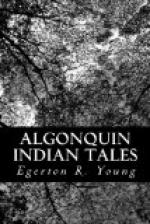At once all the Indians took it up and uttered it over and over again, so that it would not be forgotten. Even Sagastao and Minnehaha, who could talk as well in the Indian language as in English, took up the word and shouted out, Souwanaquenapeke, until they had it as thoroughly as their own.
Mary alone was vexed, and so annoyed that she could not conceal her disappointment. This was particularly noticed by Sagastao, and as soon as Minnehaha joined them they slipped quietly away together. Having obtained permission they took a canoe and went for a paddle on the quiet lake. Mary, like all other Indians, was passionately fond of the water, and in spite of her crooked back was a strong and skillful paddler.
The children were placed in the center of the canoe, on a fur rug, while Mary seated herself in the stern and paddled them over the beautiful sunlit waves.
For a time but little was heard, for the children were absorbed in the scenes of rarest beauty or watched some fish, principally the active gold eyes, sporting in the water around them.
After a while the children began to clamor for a story, but Mary would not speak a word. Sagastao suspected the cause of Mary’s unusual silence.
“What is the use, sakehou,” he protested, “of your being in a pet because baby was not named Papewpenases? The name they gave her pleased everybody else; you must be pleased too.”
“If you are cross and won’t speak to us we will go and run away to Souwanas; won’t we?” said Minnehaha.
This was too much for Mary, and she quickly surrendered and made an excuse about thinking of some beautiful story to tell them when they should land on that little rocky island just ahead of them.
“Very well,” said Sagastao, “let us have the one about how medicines were discovered and given to the Indians to cure diseases.”
“Just the one I was thinking about,” said Mary; “and while we rest on the lovely white sand I will tell you the story.”
A few vigorous strokes of the paddle sent the canoe well up on the sandy shore, and soon they all landed. A good romp relieved them of the stiffness caused by the cramped position in the canoe. Then as they cuddled down in the warm sand Mary began her story.
“You remember, little sweethearts, how the animals of various kinds held councils and decided to be revenged on the human family for their cruelty by sending diseases among them. Well, these creatures did as they said they would and the result was that lots of men died, and also the women and children, that did the creatures no harm, were getting different kinds of sicknesses and many of them were dying.
“Were there no diseases among them before these times?” inquired Minnehaha.
“No; not what you might call diseases,” replied Mary. “The people lived such simple lives that, with the exception of accident, such as being drowned in great storms or killed by falling trees, or something that way, nearly all the people died of old age.”




